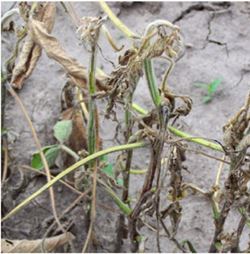Conditions Favorable For Phytophthora Root And Stem Rot On Soybean
Phytophthora root and stem rot of soybean can occur when soil conditions are wet and the soil temperature is above 65°F. The disease is caused by a soilborne pathogen known as Phytophthora sojae. Symptoms include wilting of plants, root systems with dark lesions that may be rotted, dark stem lesions extending upward from the soil line, and seedlings that have damped-off. Wet soil conditions are required for Phytophthora root and stem rot to be severe, because the pathogen produces spores (zoospores) that must “swim” through the soil to infect soybean plants. The most severely affected areas in a field generally are those that tend to hold moisture for extended periods (low areas, areas with higher clay content, etc.). Infection can take place throughout the season, and adult plants can be killed in severe conditions.
With the high amounts of rainfall received throughout Illinois, Phytophthora root and stem rot is likely to be observed more frequently this year. No “in-season” management options are available for control. The best tactic is to plant a resistant variety. Two types of resistance are available: race-specific resistance and field tolerance. In addition, some fungicide seed treatments may provide some control.

Soybean plants affected by Phytophthora root and stem rot
Race-specific resistance. Soybean varieties with race-specific resistance use one or several Rps genes to provide control of specific races of the pathogen. This type of resistance provides complete Phytophthora control as long as the races of the pathogen in the field are the same ones controlled by the specific Rps gene(s) used in that variety. Many different races of the pathogen are present in Illinois, and some can infect varieties that use some of the most common Rps genes for resistance.
Field tolerance. Field tolerance is effective against all races of the Phytophthora pathogen but does not provide complete control. Varieties with high levels of field tolerance can still be affected by Phytophthora, but they are not affected as severely as susceptible varieties. Seed companies may use varying terminology to describe “field tolerance.”
Fungicide seed treatments. Seed treatments that contain either mefenoxam or metalaxyl can provide some protection against Phytophthora but will not provide season-long control. Higher rates of mefenoxam and metalaxyl will provide better control of Phytophthora than standard rates that are typically used in Illinois. Research conducted at Ohio State University indicates that using seed treatments on varieties with high levels of field tolerance may be an effective combination in helping manage Phytophthora root and stem rot. Δ
DR. CARL A. BRADLEY: Assistant Professor Crop Production, Integrated Pest Management, Plant Pathology, University of Illinois